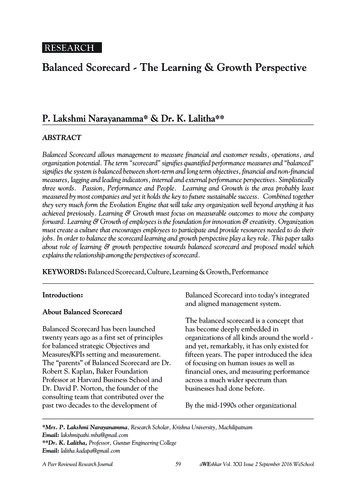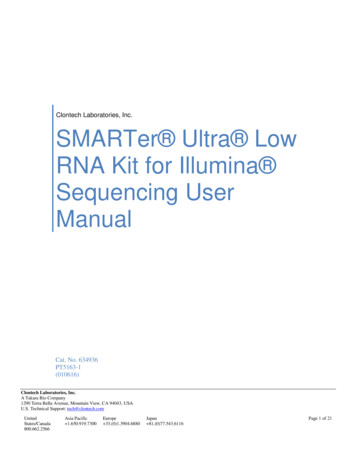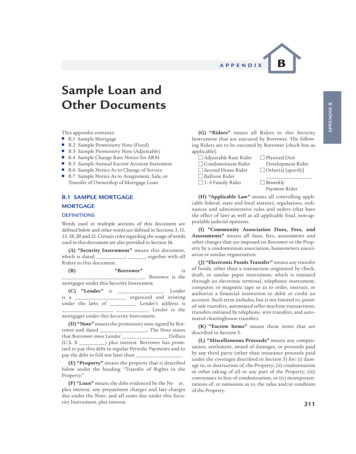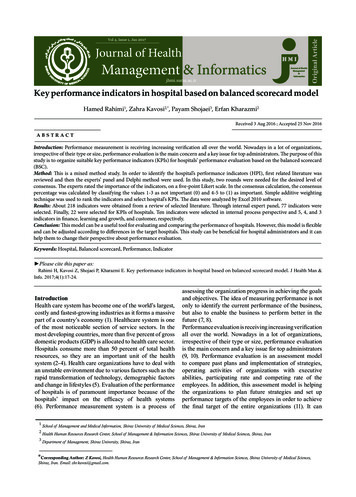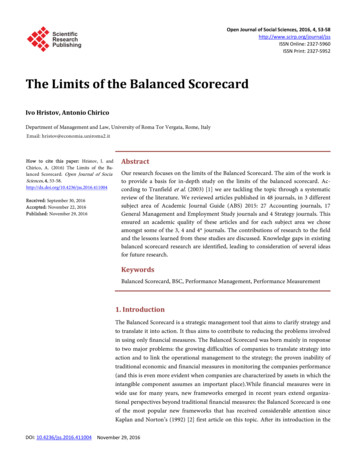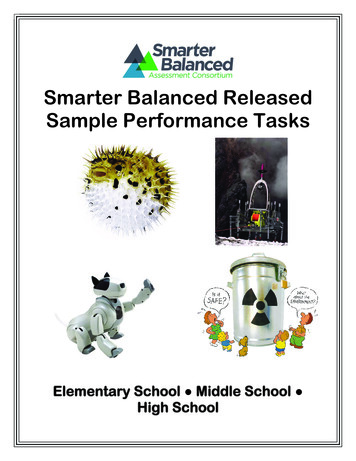
Transcription
Smarter Balanced ReleasedSample Performance TasksElementary School Middle School High School
Grade 4 Performance TaskAnimal Defenses1. Task Overview2. Classroom Activity3. Student Task: Parts 1 and 24. Task Specifications and Scoring RubricsTask Overview (20 minutes for classroom activity, 105 for performance task 125total minutes)Classroom Activity (20 minutes)Evidence StatementIn order to adequately prepare for the Animal Defenses constructed-response questionsand performance task, students will:1. Be introduced to the concept of animal defenses.2. Be engaged in a compare and contrast group activity.3. Be reminded of the qualities of an explanatory article or essay.The classroom activity is designed to take place BEFORE Part 1 and Part 2 of theperformance task. The interaction increases students' basic understanding of the topicaddressed in the constructed-response questions and the performance task, helps themaccess both assessment stimuli, and prepares students for the kind of thinking and writingthey will be asked to demonstrate in the performance task.During the classroom activity, the teacher will first introduce the topic of the assessmentand the video stimulus—"Animal Defenses"—used in the writing assessment. The teacherwill lead a whole class discussion about animal defenses using examples from the video.Students may take notes based on their ideas and the ideas of their classmates.Students may refer to their notes from the classroom activity when they plan, draft, andrevise a multi-paragraph explanatory essay in Part 2.Part 1 (35 minutes)Students will examine the sources and take notes. They will then respond to three (3)constructed-response questions.1
Grade 4 Performance TaskPart 2 (70 minutes)Students will have access to the sources they examined in Part 1. They will refer to theirnotes and their answers to the constructed-response questions to compose a full-lengthexplanatory article. Students cannot change their answers to the constructed-responsequestions. They will pre-write, draft, and revise an article.Scorable ProductsStudents will not generate scorable products during the classroom activity. Studentresponses to the constructed-response questions at the end of Part 1 and the articlecompleted in Part 2 will be scored. Notes completed in Part 1 and pre-writing and draftingin Part 2 will not be scored.Teacher Preparation / Resource RequirementsThis is a computer-based test that requires an interface for each test-taker. The testingsoftware will include access to spell check, but not to grammar check. The teacher shouldensure that sufficient blank paper and writing tools are available for student note-taking.Teacher Directions for the Classroom ActivityIntroductory Classroom Activity (20 minutes)STEP 1: Orientation to the Topic ( 4 minutes)Provide an introduction to the classroom activity by indicating that after this activity,students will be completing an assessment focused on the topic of animal defenses. Writethe word defense on the board and ask students what it means. (They may be helped bybeing reminded of uses of the term like "self-defense.") Be sure that students understandthat a defense is a protection from a threat or harmful condition.Remind students that humans have to defend themselves too. Ask: "What are some of thethings humans have to defend themselves from? Have you or someone you know ever hadto find protection from a threat of some kind? What are some of the defenses that humanshave created or used for protection?"STEP 2: Accessing the Stimuli ( 13 minutes)1. Explain: "Now we will look at some animal defenses." Show the video "Animal Defenses"(3 minutes 5 seconds).2. Lead a whole class discussion about the video using the questions below (10 minutes):2
Grade 4 Performance TaskQuestion 1: In the video "Animal Defenses," what were the animals defendingthemselves against?Question 2: How do these defenses help the animals protect themselves againstenemies?STEP 3: Clarify Expectations for the Writing Task ( 3 minutes)Explain: "In a few minutes you will read an article and answer some questions about animaldefenses from both the article and the video we just saw. Then you will write an explanatoryessay in response to a particular question."Explain what students are expected to do in their explanatory essay:An explanatory essay: Explains information clearlyIs well organized and stays on the topicProvides evidence from the sources to support your main ideaUses clear language that suits your purposeFollows rules of writing (spelling, capitalization, punctuation, and grammar)Answer questions that students might have about the task. Students will keep their notesfrom this classroom activity for the "Animal Defenses" assessment.Teacher Directions for Parts 1 and 2Part 1 (35 minutes)Students should receive the sources, directions, questions, article assignment, and anyother material related to the task. They should receive the constructed-response questionsin Part 1 and the article assignment in Part 2.1.2.3.4.5.Initiate the online testing session.Alert the students when there are 15 minutes remaining in Part 1.Alert the students when there are 5 minutes remaining in Part 1.Have students write their names on any notes. Collect all student notes.Close the testing session.Stretch Break3
Grade 4 Performance TaskPart 2 (70 minutes)1. Initiate the testing Part 2.2. Allow students to access the sources, their notes, and their answers to theconstructed-response questions presented in Part 1. They will not be allowed tochange their answers.3. Once 15 minutes have elapsed, suggest students begin writing the article.4. Alert the students when 30 minutes remain.5. Alert students when 15 minutes remain and suggest they begin revising theirarticles.6. Close the testing session.4
Grade 4 Performance TaskStudent Directions for Parts 1 and 2Part 1 (35 minutes)Your taskYou will read an article and watch a video about what animals do to defend themselvesfrom danger. Then you will answer three questions about what you have learned. In Part 2,you will write an article that explains how some animals defend themselves.Steps to followIn order to plan and write your article, you will do the following:1. Examine two sources.2. Make notes about the information from the sources.3. Answer three questions about the sources.Directions for beginningYou will now examine two sources. Take notes on both sources. You may use the graphicorganizers to organize your notes if you like. You will want to refer to your notes whilewriting your article, but your notes will not be scored. You can re-read the article and watchthe video as often as you like.5
Grade 4 Performance TaskNOTESSOURCE 1: "Animal Roll-Ups" (Ranger Rick article)AnimalType of DefenseNOTE: Your notes will not be scored.6
Grade 4 Performance TaskNOTESSOURCE 2: "Animal Defenses" (National Geographic video)AnimalType of DefenseNOTE: Your notes will not be scored.7
Grade 4 Performance TaskResearch QuestionsAfter examining the research sources, use the remaining time in Part 1 to answer threequestions about them. Your answers to these questions will be scored. Also, your answerswill help you think about the research sources you have read and viewed, which should helpyou write your explanatory article.You may click on the source buttons to refer back to the sources when you think it would behelpful. You may also refer to your notes. Answer the questions in the spaces providedbelow them.1. What does the article "Animal Roll-Ups" tell you about why some animals curlup? Use details from the article to support your answer.2. Think about the armadillo and the hedgehog described in the article "AnimalRoll-Ups.” In what way are their defenses similar or different? Explain youranswer using details from the article.3. In the video "Animal Defenses," the puffer fish and the crab were bothsuccessful in protecting themselves from the same enemy—the sea otter. Dothe puffer fish and the crab have the same type of defense? Explain your answerand include details from the video in your response.Part 2 (70 minutes)You will now have 70 minutes to review your notes and sources, plan, draft, and revise yourarticle. You may use your notes and refer to the sources. You may also refer to the answersyou wrote to questions in Part 1, but you cannot change those answers. Now read yourassignment and the information about how your article will be scored; then begin yourwork.Your AssignmentYour class is preparing a museum display that will include photos of a variety of animalsand interesting facts about them. You have been asked to write an article for the museumdisplay explaining about animal defenses.8
Grade 4 Performance TaskIn your articleChoose one animal from the article "Animal Roll-Ups" and one animal from the video"Animal Defenses." In your article, identify your two animals, explain how each animalprotects itself from its enemies, and explain how the two animals’ defenses are similar toor different from one another. Include details from your sources.Now begin work on your article. Manage your time carefully so that you can: plan your articlewrite your articlerevise and edit for a final draftWord-processing tools and spell check are available to you.Type your response in the space provided. Write as much as you need to fulfill therequirements of the task; you are not limited by the size of the response area on the screen.REMEMBER: A well-written explanatory article: has a clear main ideais well-organized and stays on the topicprovides evidence from the sources to support your topicuses clear language that suits your purposefollows rules of writing (spelling, punctuation, and grammar)Source Information:Stimulus #1Read this article about animals that roll up to defend themselves.“Animal Roll-Ups” by Kathy Kranking, from Ranger Rick Magazine. Copyright September2011 by the National Wildlife Federation.Stimulus #2Now watch this video about animals and how they defend themselves.“Animal Defenses.” Teachers’ Domain. 26 Sept. 2003. Web. 18 Sept. 2012.Sep. 2012.9
Grade 4 Performance TaskTask Specifications:Title: “Animal Defenses”Grade: 4Claim(s): 2: Students can produce effective writing for a range of purposes andaudiences.4: Students can engage in research/inquiry to investigate topics and toanalyze, integrate, and present information.Primary Target(s): These claims and targets will be measured by scorable evidence collected.Claim 2 4: COMPOSE FULL TEXTS: Write full informational/explanatorytexts on a topic, attending to purpose and audience: organize ideas bystating a focus, include structures and appropriate transitional strategiesfor coherence, include supporting evidence (from sources whenappropriate to prompt) and elaboration, and develop an appropriateconclusion.8: LANGUAGE AND VOCABULARY USE: Strategically use language andvocabulary (including academic and domain-specific vocabulary)appropriate to the purpose and audience when revising or composingtexts.9: EDIT/CLARIFY: Apply or edit grade-appropriate grammar usage andmechanics to clarify a message and edit narrative, informational, andopinion texts. Claim 4 2: INTERPRET AND INTEGRATE INFORMATION:Locate information to support central ideas and subtopics; select andintegrate information from data or print and non-print text sources. 3:ANALYZE INFORMATION/SOURCES: Distinguish relevant-irrelevantinformation (e.g., fact/opinion).CCSS/Standard(s): W-8, W-9DOK: 4Difficulty: MediumScore Points: Up to 10Task Source: SBAC / CTB / Revisions by Stanford Center for Assessment, Learning, &Equity (SCALE)Item Type: Performance TasksTarget-specific Students with visual impairments may need alternative formats to accessattributes (e.g., written texts, graphic stimuli, and video or audiovisual material.accessibility issues): Students with physical or other impairments may need to be provided withappropriate alternative means to entering lengthy text using a keyboard.Grade level of stimuli: 3/4Stimuli: Animal Roll-Ups: Informational articleThis article talks about animals that roll up to protect themselves frompredators.Animal Defenses: Educational videoThis National Geographic video talks about animals and their different10
Grade 4 Performance Taskdefenses.How this task In order to complete the performance task, students 1. Analyze and selectcontributes to sufficient information from multiple sources 2. Answer various questions aboutevidence for the claims: research and the evidence the authors present as support 3. Write anexplanatory article, attending to purpose and audience 4. Organize ideasby stating and maintaining a focus 5. Develop a topic, including citingsupportive evidence, details, and elaboration consistent with the sources,purpose, and audience 6. Effectively organize ideas, appropriatetransitions, and include a conclusion for coherence 7. Adhere toconventions and rules of grammar, usage, and mechanics 8. Controllanguage for purpose and audience11
Grade 4 Performance TaskScoring information for questions:1. Claim 4, Target 32-point Research (Grades 4–5)Evaluate Information/Sources Rubric (Claim 4, Target 3)The response gives sufficient evidence of the ability to distinguish relevantfrom irrelevant information such as fact from opinion.2The response includes detailed information from the text about how someanimals roll up to defend themselves rather than for other purposes (such askeeping warm). The response is supported with relevant details from the text.The response gives limited evidence of the ability to distinguish relevant fromirrelevant information such as fact from opinion.1The response includes limited information from the text about how someanimals roll up to defend themselves rather than for other purposes (such askeeping warm). The response is supported with limited relevant details fromthe text.A response gets no credit if it provides no evidence of the ability to distinguishrelevant from irrelevant information such as fact from opinion.0The response does not include an explanation of how some animals roll up todefend themselves rather than for other purposes (such as keeping warm) orconfuses the reasons why animals roll up. The response does not includerelevant details and may be vague, incorrect, or completely absent.12
Grade 4 Performance TaskSample 2-Point Response:The information in the article tells about many animals that roll up in different ways. Manyanimals roll up to protect themselves from danger. For example, the armadillo rolls up intoa ball by pulling its ears and legs into the ball and has armor covering it. Some animals, likethe red fox, curl up to keep warm. The stone centipede rolls up into a ball to protect hereggs.Scoring note: The response could also mention the pill bug, hedgehog, or wheel spider.Sample 1-Point Response:The article “Animal Roll-Ups” did a good job of explaining how animals roll up. It alsoexplains why they roll up. The pill bug rolls up like an armadillo.Sample 0-Point Response:I liked reading about animals that roll up.13
Grade 4 Performance Task2. Claim 4, Target 22-point Research (Grades 3–5)Interpret & Integrate Information Rubric (Claim 4, Target 2)The response gives sufficient evidence of the ability to locate, select, interpret,and integrate information within and among sources of information.2The response is a thorough explanation of how the defenses of the armadilloand the hedgehog are similar or different. The response is supported withrelevant details from the text.The response gives limited evidence of the ability to locate, select, interpret,and integrate information within and among sources of information.1The response is a limited explanation of how the defenses of the armadillo andthe hedgehog are similar or different. The response is supported with limiteddetails from the text.A response gets no credit if it provides no evidence of the ability to locate,select, interpret, and integrate information within and among sources ofinformation.0The response does not relate to the similarities or differences of the defensesof the armadillo and the hedgehog. The response does not include relevantdetails and may be vague, incorrect, or completely absent.14
Grade 4 Performance TaskSample 2-Point Response:Armadillos and hedgehogs defend themselves in similar ways because they both try to fooltheir enemies and protect their bodies. Armadillos curl up into a ball and pull their head andtail inside their armor. Hedgehogs also curl up into a ball and hide their soft parts undertheir sharp spines. These defenses help the animals protect themselves.Sample 1-Point Response:Armadillos and hedgehogs curl up into balls to defend themselves.Sample 0-Point Response:I enjoyed reading the article.3. Claim 4, Target 22-point Research (Grades 3–5)Interpret & Integrate Information Rubric (Claim 4, Target 2)The response gives sufficient evidence of the ability to locate, select, interpret,and integrate information within and among sources of information.2The response is a thorough explanation of whether or not the puffer fish and thecrab have the same type of defense. The response is supported with relevantdetails from the video.The response gives limited evidence of the ability to locate, select, interpret,and integrate information within and among sources of information.1The response is a limited explanation of whether or not the puffer fish and thecrab have the same type of defense. The response is supported with limitedrelevant details from the video.15
Grade 4 Performance TaskA response gets no credit if it provides no evidence of the ability to locate,select, interpret, and integrate information within and among sources ofinformation.0The response does not include an explanation of whether or not the puffer fishand the crab have the same type of defense. The response does not includerelevant details and may be vague, incorrect, or completely absent.Sample 2-Point Response:The puffer fish and the crab have very different types of defenses. The puffer fish puffs up tomake itself so large that an enemy can’t bite it. It also makes itself hard to bite withthousands of prickles on it. The crab has sharp claws that it snaps at the otter in the video,and this keeps the otter away from it. They have very different responses, but they are bothsuccessful at defending themselves.Sample 1-Point Response:The puffer fish puffs up to make itself so large that the otter can’t bite it. The crab in thevideo uses its claws to snap at the otter. In these ways they are different.Sample 0-Point Response:Otters like to try to eat puffer fish and crabs.16
Grade 4 Performance TaskRubric and scoring information for ce Task Writing Rubric (Grades 3–5)Statement of Purpose/Focus and OrganizationScore4321NSThe response is fullysustained andconsistently andpurposefully focused: controlling idea ormain idea of a topicis clearly stated,focused, and stronglymaintained controlling idea ormain idea of a topicis introduced andcommunicatedclearly within thepurpose, audience,and taskThe response isadequately sustainedand generally focused: controlling idea ormain idea of a topicis clear and mostlymaintained, thoughsome looselyrelated materialmay be present some context forthe controlling ideaor main idea of thetopic is adequatewithin the purpose,audience, and taskThe response issomewhatsustained and mayhave a minor drift infocus: may be clearlyfocused on thecontrolling ormain idea, butis insufficientlysustained, or controlling ideaor main ideamay be unclearand/orsomewhatunfocusedThe response maybe related to thetopic but mayprovide little or nofocus: may be verybrief may have amajor drift focus may beconfusing orambiguousInsufficient,illegible, in alanguageother thanEnglish,incoherent,off-topic, oroff-purposewritingThe response has a clearand effectiveorganizational structurecreating a sense of unityand completeness: consistent use of avariety of transitionalstrategies to clarifythe relationshipsbetween and amongideas logical progression ofideas from beginningto end effective introductionand conclusion foraudience andpurposeThe response has anevident organizationalstructure and a sense ofcompleteness, thoughthere may be minorflaws and some ideasmay be looselyconnected: adequate use oftransitionalstrategies withsome variety toclarify therelationshipsbetween and amongideas adequateprogression of ideasfrom beginning toend adequateintroduction andconclusionThe response has aninconsistentorganizationalstructure, and flawsare evident: inconsistent useof transitionalstrategiesand/or littlevariety unevenprogression ofideas frombeginning toend conclusion andintroduction, ifpresent, areweakThe response haslittle or nodiscernibleorganizationalstructure: few or notransitionalstrategies areevident frequentextraneousideas mayintrude17
Grade 4 Performance Task4-PointInformative-ExplanatoryPerformance Task Writing Rubric (Grades 3–5)Evidence/ElaborationScore4321NSThe response providesthorough and convincingsupport/evidence for thecontrolling idea or mainidea that includes theeffective use of sources,facts, and details: use of evidence fromsources is integrated,comprehensive, andrelevant effective use of avariety of elaborativetechniquesThe response providesadequatesupport/evidence for thecontrolling idea or mainidea that includes theuse of sources, facts,and details: some evidence fromsources is included,though citationsmay be general orimprecise adequate use ofsome elaborativetechniquesThe responseprovides uneven,cursorysupport/evidencefor the controllingidea or main ideathat includes partialor uneven use ofsources, facts, anddetails: evidence fromsources isweaklyintegrated, andcitations, ifpresent, areuneven weak or unevenuse ofelaborativetechniquesThe responseprovides minimalsupport/evidencefor the controllingidea or main ideathat includes littleor no use ofsources, facts, anddetails: use ofevidence fromthe sourcematerial isminimal,absent,incorrect, orirrelevantInsufficient,illegible, in alanguageother thanEnglish,incoherent,off-topic, oroff-purposewritingThe response clearly andeffectively expressesideas, using preciselanguage: use of academic anddomain-specificvocabulary is clearlyappropriate for theaudience andpurposeThe responseadequately expressesideas, employing a mixof precise with moregeneral language: use of domainspecific vocabularyis generallyappropriate for theaudience andpurposeThe responseexpresses ideasunevenly, usingsimplistic language: use of domainspecificvocabulary thatmay at times beinappropriatefor the audienceand purposeThe response’sexpression of ideasis vague, lacksclarity, or isconfusing: uses limitedlanguage ordomainspecificvocabulary may have littlesense ofaudience andpurpose18
Grade 6 Performance TaskStudent DirectionsRobots Narrative Performance TaskTask:Your school's technology club is building a new website. The club sponsor is also yourEnglish teacher, and he has encouraged everyone to research a topic related to technologyfor an upcoming project. Since you saw a movie about robots recently, you want to knowmore about what real robots can do. During your research, you have found three articlesabout robots.After you have reviewed these sources, you will answer some questions about them. Brieflyscan the sources and the three questions that follow. Then, go back and read the sourcescarefully so you will have the information you will need to answer the questions andcomplete your research. You may click on the Global Notes button to take notes on theinformation you find in the sources as you read. You may also use scratch paper to takenotes.In Part 2, you will write a story on a topic related to the sources.Directions for Beginning:You will now examine several sources. You can re-examine any of the sources as often asyou like.Research Questions:After examining the research sources, use the rest of the time in Part 1 to answer threequestions about them. Your answers to these questions will be scored. Also, your answerswill help you think about the information you have read and viewed, which should help youwrite yourstory.You may click on the Global Notes button or refer back to your scratch paper to review yournotes when you think it would be helpful. Answer the questions in the spaces below theitems.Both the Global Notes on the computer and your written notes on scratch paper will beavailable to you in Part 1 and Part 2 of the performance task.1
Grade 6 Performance TaskPart 1Sources for Performance Task:Source #1The following is an article about several robots and the jobs they perform.Meet the Robotsby Lucas LangleyIf you think of robots as a thing of the future, think again. Robots do many jobs today. Theywork in mines and on farms, they help doctors and save lives, and even explore volcanoes.Here are some robots that are hard at work.Gemini-ScoutGemini-Scout is a remote-controlled robot that does search-and-rescue work in minesunder the ground. The robot is less than two feet tall and has wheels which enable it to goup and down stairs and make tight turns—it can even roll through water! Gemini may besmall, but it is strong and can easily carry food, water, and other supplies. In realemergencies, Gemini can even drag an injured person to safety.Wherever it goes, Gemini-Scout constantly collects information. For example, it tests theair for gases and then tells miners when the air is safe. The robot also has a thermalcamera, a special camera that locates heat energy to produce images that help it findminers who are trapped underground.Once the robot finds the trapped miners, the miners can use the robot's two-way radio totalk with the rescue team. This robot was built to be easy to use because its remote controloperates like a remote control used for many video games. If you've ever played a videogame, you would probably know how to use Gemini-Scout.Dante 2Although Dante 2 isn't saving lives directly like Gemini-Scout, its jobis just as interesting and important. Dante 2's job is to climb intovolcanoes to gather information for scientists. Like a spider, thisrobot has eight legs, which can help it climb the steep walls of thevolcano while secured with a rope. Dante 2 is also built to surviveextreme heat. When a volcano is too dangerous for scientists toenter, Dante 2 goes instead.Once in the volcano, Dante 2 looks for vents, or holes, in the crater.Then the robot collects information about the gases that come outof the vents. In the past, scientists could not learn as much aboutvolcanoes, but Dante 2 is changing that. Now scientists can study avolcano up close while remaining at a safe distance.2
Grade 6 Performance TaskDante 2 (NASA)Mr.GowerAt first glance, Mr. Gower looks like a small metal cabinet on wheels, but its job is just asimportant as Dante 2 and Gemini-Scout. Mr. Gower is a robot that moves throughout ahospital, helping doctors and nurses bring medicine to patients. The body of the robot is astack of locked drawers that store medicine. Nurses and doctors can unlock the drawersand get the medicine they need for their patients.Mr. Gower can be programmed to go anywhere in the hospital. It can ride elevators, steerthrough hallways, and even move around things that get in the way. The robot is so strongthat it can pull 500 pounds. Mr. Gower is battery powered, and after charging for only twohours, the robot can deliver medicine for twelve hours without stopping.Not only does it work long days, but Mr. Gower can talk. It has been programmed to sayhundreds of phrases like "Calling elevator" or "Your delivery is here." Mr. Gower reduces theamount of time doctors, pharmacists, and nurses spend walking around the hospital,allowing them to use their time to focus on other important tasks.AgribotsAgribots may not save lives, but many farmers find them very useful. An agribot is a robotthat picks fruit. It might pick berries, oranges, grapes, or apples. Agribots are not yet widelyused, but farmers are very interested in what these robots can do. Because picking astrawberry is different than picking an apple, agribots come in all shapes and sizes. Somehave giant arms that are towed behind trucks, while others are able to move around ontheir own. In Japan, there is a strawberry-picking robot that can sense the color of theberries. This helps the robot know when each berry is ripe.At the Massachusetts Institute of Technology (MIT), scientists are working to grow cherrytomatoes with no human help at all! They have created a greenhouse full of plants that arecared for by small agribots. The agribots are like robot farmers. Every plant has sensorsthat tell the robots what the plant needs. If a plant is too dry, a robot will water it. When arobot senses that a tomato is ripe, it uses a mechanical arm to pick the tomato. Agribotsmay seem unusual now, but one day they may be common on farms.No matter how large or small a robot's job, one thing is for certain—robots are here to stay.Because robots are dependable and tireless, they are valuable tools, and as technologyadvances, they will be capable of doing increasingly complex jobs.ReferencesDillow, C. (2011). Rescue robot just made for mine disasters. NBC News.Retrieved -just-made-mine-disasters-1212513
Grade 6 Performance TaskLeary, W. E. (1994). Robot completes volcano exploration. The New YorkTimes. Retrieved pletes-volcano-exploration.htmlBares, J., & Whittaker, W. L. Dante II. Carnegie Mellon: The RoboticsInstitute. Retrieved fromhttp://www.ri.cmu.edu/research project detail.html?project id 163&menu id 261Rivers, C., & Boston, S. (2004). Robot delivers medications at shocktrauma center. University of Maryland Medical Center. Retrieved fromhttp://umm.edu/news-and-events/news
Task Specifications and Scoring Rubrics. Task Overview (20 minutes for classroom activity, 105 for performance task 125 total minutes) . Web. 18 Sept. 2012.Sep. 2012. Grade 4 Performance Task 10 Task Specifications: Title: "Animal Defenses" Grade: 4 Claim(s): 2: Students can produce effective writing for a range of purposes and
